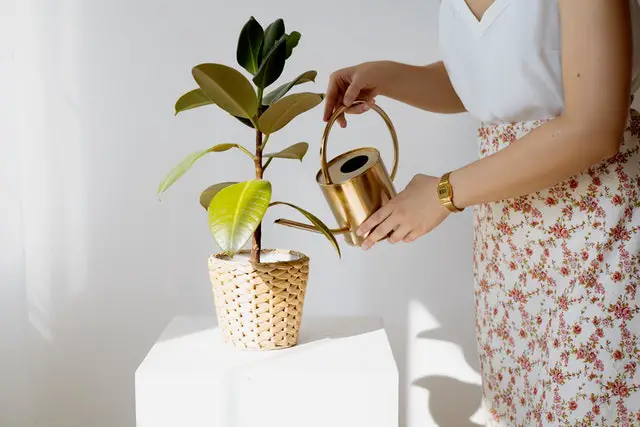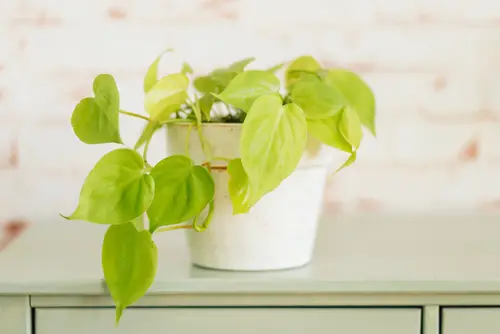You might be confused between the philodendron lemon lime and moonlight types as a plant lover. They do belong to the same genus, but there are several differences that you can easily identify in this philodendron lemon lime vs. moonlight comparison.
So, keep reading to learn more about these varieties as we highlight their differences and similarities to help you pick the right one.
Philodendron Lemon Lime vs. Moonlight Summary of Main Differences

Philodendron lemon lime plant has heart-shaped leaves, and the plant itself grows as a vine. The philodendron moonlight plant has stiff stems so it’s self-heading, and its leaves are bright and elongated.
The whole philodendron lemon lime plant grows to be slightly larger than the moonlight variety. The moonlight variety is usually brighter, and the leaves look waxier. However, it might be challenging to tell them apart when both plants are young.
| Philodendron Lemon Lime | Philodendron Moonlight | |
| Leaf Color | The leaves are neon green with blue and yellow undertones and appear matte in color | The leaves are dark green with a waxy shiny look |
| Stem Color | Stems are green | Stems are brownish green |
| Variegation | Some types can have dark and bright green hues | Some rare moonlight variegated types show yellow or neon green shades turning dark green as the plant matures |
| Flower | White or yellowish and looks much like a peeled banana | White spadix surrounded by a pink to red spathe |
Philodendron Lemon Lime vs. Moonlight Differences
Several differences set the philodendron lemon lime and moonlight plants apart, and we’ll discuss them in this section to help you pick the suitable one.
1. Origin and Name
The philodendron plant belongs to the Araceae family that originally comes from South and Central America. The lemon lime cultivar is a new lab-created cultivar that was grown for the first time in China in 2004, and it’s called philodendron hederaceum.
The moonlight variety comes from the same family in South and Central America. It’s known for its bright neon-colored leaves.
2. Taxonomy
The Philodendron genus is subdivided into three subgenera, but the lemon lime and moonlight varieties belong to the same one. These two cultivars differ in the way the leaves look.
Scientists use the leaves pattern to name them. The lemon lime variety is neon-green, resembling the color of lemons. The moonlight variety is dark green, with a glossy and shiny finish like the moonlight.
3. Shape & Appearance
The philodendron lemon lime plant has two types of leaves. They can either be heart-shaped or long.
The philodendron moonlight plant has elongated, slightly smaller leaves. They also follow a self-heading pattern in growth, unlike the lemon lime variety, which grows on a vine.
4. Differences in Color
The philodendron lemon lime leaves look bright yellow with a pink tinge and turn bright yellow-green when they mature. The moonlight leaves are bright yellow-green, turning dark green when they mature.
The leaves of the philodendron lemon lime plant are matte, while the moonlight plant is glossy and shiny. Variegation is rare in the moonlight variety, but the leaves can come in different shades of light and dark green.
5. Leaf Size and Texture

The philodendron lemon lime variety has large leaves with a matte finish. The moonlight variety has small elongated shiny leaves.
The average leaf of the lemon lime measures 8 inches wide and about 6 inches long, while the moonlight plant’s leaf measures 6 inches wide and 10 inches long.
6. Height and Growth Rate
The philodendron lemon lime plant can grow to reach a maximum height of 20 inches, but it needs support as it grows as a vine. Moonlight is self-heading and can reach a maximum height of 3 feet.
While both plants have a similar growth rate, the philodendron lemon lime variety tends to grow a larger number of leaves.
7. Flowers
Both varieties of the philodendron plant grow similar-looking flowers. The flowers of the lemon lime variety are small and are either white or yellow, and they bloom from June to September.
The flowers of the moonlight variety are warmer in color, so they can be pink or red. They bloom between May and October.
8. Growing Conditions, Temperature, and Climate
The philodendron lemon lime plant needs stalk support as it grows as a vine. This is something that the moonlight variety doesn’t require.
Both varieties thrive in temperatures between 70 and 75 degrees Fahrenheit, which is close to the tropical temperature in their natural habitat. However, they can tolerate slightly higher or slightly lower temperatures.
Nevertheless, both varieties can’t handle freezing temperatures, although the moonlight variety is more tolerant of the cold. They both need to grow in low to medium humidity as they thrive when the humidity level is around 70%. In higher levels of humidity, these plants will grow bigger leaves.
9. Light, Water, and Soil

Philodendron varieties need to be exposed to indirect sunlight, and the lack of sunlight inhibits growth. However, the lemon lime variety needs a little more light than the moonlight variety.
Both varieties need to grow in moist but not soggy soil. However, the moonlight variety needs less water to grow well in an upright position.
Both the philodendron lemon lime and moonlight varieties need to grow in rich, slightly acidic soil, although the lemon lime variety can grow in neutral or slightly alkaline soil, too. However, because the roots of the moonlight variety grow up and down, the soil needs to be less compact.
10. Fertilization
The philodendron plant is a heavy feeder, so adding fertilizer will support the plant’s growth. Adding a monthly fertilizer is essential in the growing season, although you should decrease the amount in fall and completely stop feeding in winter.
Because the lemon lime variety has bigger leaves, it needs more regular fertilization than the moonlight variety.
Philodendron Lemon Lime vs. Moonlight Similarities
The philodendron lemon lime and moonlight varieties belong to the same family and share several similarities.
1. Sunlight
Both varieties thrive in bright indirect sunlight. They can tolerate some shade but need to be exposed to the sun to grow.
2. Watering

You need to water your philodendron plants when the soil doesn’t feel moist. In most cases, it’s suitable to water your plant once or twice a week in summer and every ten days in winter.
3. Humidity & Temperature
Both varieties of the philodendron plant prefer to grow in a humid and warm climate. Therefore, you should avoid placing them near a heater which can make them too dry.
4. Potting and Soil
You need to pick a slightly acidic soil or potting mix for your philodendron plant. Since these plants are fast growers, they need regular repotting.
5. Fertilizer
An all-purpose fertilizer is an excellent choice for your philodendron plants, so you can apply it in the growing season to support the plant’s growth. You can also pick a slow-release granular fertilizer to release nutrients during the growing season.
6. Natural Habitat
In their natural habitat, philodendron plants can grow in the shade of big trees, but they still need to get some bright sunlight. However, extended exposure to direct sunlight can scorch the leaves.
Common Problems For Both Plants
The philodendron lemon lime and moonlight plants can suffer from several issues if they don’t grow in the optimum growing conditions.
1. Leaves Turning Yellow
Having yellow or pale leaves is common in philodendron plants if you’re overwatering your plant or it’s not receiving enough light. This can also happen if the plant is growing in poor soil or you’re not providing it with enough nutrients. Adding a fertilizer will solve this problem.
2. Leaves Turning Brown
The leaves of your philodendron plant can turn brown if it’s receiving too much water or sunlight. Excessive watering can cause root rot which affects the plant’s ability to absorb nutrients. The bright sunlight can also burn the leaves and cause them to turn brown.
3. Leaves Falling Off
The stems of your plant can go limp, and the leaves will droop and fall off due to several reasons like low light, excessive watering, root rot, or low humidity. Adjusting the growing conditions of the plant will help it restore its healthy look.
4. Infestation of Insects and Mites

These plant varieties are resistant to diseases and pests, but they can be infected with aphids and mealybugs if you don’t pay attention to your plant.
However, applying insecticidal soap will help you get rid of these pests and restore the look of your plant. You should also make sure that there’s enough ventilation around the plant.
See other plant comparisons:
- Peperomia Silver Ripple vs. Frost
- Crystallinum vs Clarinervium
- Neon Pothos vs Lemon Lime Philodendron Comparison
Summary
The philodendron lemon lime and moonlight varieties belong to the same plant family, but there are some differences that set the two varieties apart, and we tried to highlight them in this philodendron lemon lime vs. moonlight comparison.
The main difference between these two plant varieties is in the color and size of leaves, as the lemon lime cultivar has bigger and brighter leaves. Its leaves are also of matte color, while the leaves of the moonlight cultivar are dark and waxy.
Moreover, there are several minor differences in the growing conditions that you need to pay attention to while growing both species. Yet, they’re both excellent houseplants and will add a lot of positive vibes to your indoor space.
Frequently Asked Questions
Is Neon Philodendron the same as Lemon Lime Philodendron?
Both varieties have heart-shaped leaves, but the leaves of the lemon lime cultivar are more heart-shaped and have a slightly softer texture. Moreover, the lemon lime variety can grow in neutral or slightly alkaline soil, while the neon variety will only grow below 6.5 pH levels.
Are Lemon Lime philodendrons rare?
This cultivar is one of the most popular varieties of the philodendron plant

Hey, I’m Lisa and I’ve been an avid gardener for over 30 years. I love writing, talking and living in the garden! Feel free to connect with me on my socials below

